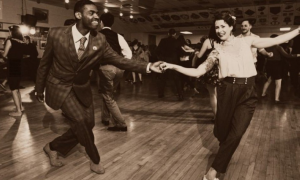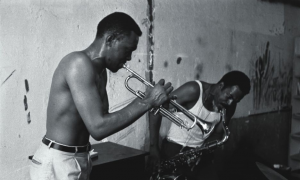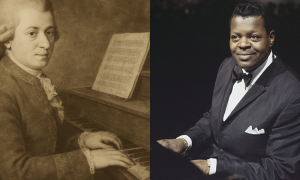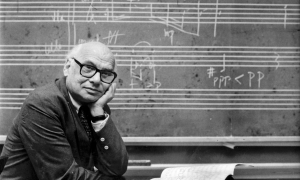Home » Jazz Articles » Opinion » The Hi-Lo's: An Appreciation
The Hi-Lo's: An Appreciation
They [The Hi-Lo's] worked in collaboration with some of the best of the swing-based arrangers in the '50s; including Nelson Riddle, Frank Comstock, Jerry Fiedling, Marty Paich, and Billy May.
 Looking back on the long history of popular music in the U.S., there are fewer periods as overlooked or misunderstood as the post WWII to pre-rock ‘n’ roll period---or roughly 1946 to 1956. Tucked away in that ten year time frame, hidden away in the awful dreck of novelty tunes and saccharine love songs so common in that era was a vocal group with a style and substance that confounded critics, arrangers, and record producers alike. In fact, they were so singular they confounded many record buyers as well.
Looking back on the long history of popular music in the U.S., there are fewer periods as overlooked or misunderstood as the post WWII to pre-rock ‘n’ roll period---or roughly 1946 to 1956. Tucked away in that ten year time frame, hidden away in the awful dreck of novelty tunes and saccharine love songs so common in that era was a vocal group with a style and substance that confounded critics, arrangers, and record producers alike. In fact, they were so singular they confounded many record buyers as well. Despite this fact, their many hard-core fans included the likes of Frank Sinatra, Mel Torme, Rosemary Clooney, Nelson Riddle, Sammy Davis, Jr, Jose Ferrer, Steve Allen ("without a doubt the best vocal group of all time."), Bing Crosby ("these guys are so good they can whisper in harmony."), Marty Paich, Ralph Farnon and many more. Herbie Hancock has even remarked that as a young student at Grinnell College he would study the group's records for their sophisticated harmonies.
The group was called the Hi-Lo’s. And, even if you’ve never heard the name before, their legacy has been carried forth by contemporary groups such as The Manhattan Transfer, Take 6, The New York Voices, The Bobs, and Chanticleer.
Formed in Los Angeles in 1952 by transplanted Milwaukee native Gene Puerling, the four-man vocal group (Puerling, Clark Burroughs, Bob Strasen, and Bob Morse) began recording for two small L.A. area labels (Trend, then Starlight) in 1953. Over the next three years they produced four albums as a small but rabid collection of fans spread the word about this frighteningly talented, and impossible to define quartet.
Together, these four men could flawlessly execute seemingly impossible vocal leaps all while keeping perfectly in tune. They would use comic vocal touches, trumpet-like vocal shakes, contrary motion, and wide spread voicings. They recorded with twenty to thirty piece orchestras using complex, multi-faceted arrangements mixing jazz with barbershop, folk, musical theater, classical; and, they sang the most sophisticated and beautiful chord changes ever heard from a vocal group—in any idiom. Finally, like Sinatra, they always had a special way with telling a lyric. They worked in collaboration with some of the best of the swing-based arrangers in the '50s; including Nelson Riddle, Frank Comstock, Jerry Fiedling, Marty Paich, and Billy May.
In 1956 Rosemary Clooney asked the group to be regulars on her syndicated half-hour television variety show. By the end of that year power-house recording company Columbia came calling and signed the group. Their first album, Suddenly It’s the Hi-Lo’s, sold over 100,000 copies and made the top twenty LPs for a brief time. Although the group went on to put out seven more recordings for the label between 1957 and 1961 , including a critically acclaimed project with Marty Paich called “And All That Jazz”, none of the subsequent releases sold like “Suddenly”.
In 1961, Don Shelton had been part of the group for two years, replacing departing member Bob Strasen in he summer of 1959. After Columbia dropped the group in 1961 Frank Sinatra, a long time admirer, signed them for his new Reprise label. The group recorded two LPs and although both were musically arranged for wider market appeal, neither recording ( The Hi-Lo’s Happen to Bossa Nova, and, The Hi-Lo’s Happen to Folk ) sold well. In 1963 Reprise dropped them from its roster. Shelton left the group the next year to join a commercial jingle group.
 Following his departure the group stopped performing but spent time doing advertising jingles whenever they could pick them up. To fill out the quartet, Puerling, Burroughs, and Morse would use a temporary fourth member until they fully disbanded in 1966.Fourteen years after their last performance, in 1978, the group was asked if they’d make a special appearance at the Monterey Jazz Festival as a favor to festival producer and co-founder Jimmy Lyons. They agreed to regroup for the Monterey performance and their appearance was a huge success—leading to two new albums recorded for MPS records in 1978 and in 1980— Back Again,and Now.
Following his departure the group stopped performing but spent time doing advertising jingles whenever they could pick them up. To fill out the quartet, Puerling, Burroughs, and Morse would use a temporary fourth member until they fully disbanded in 1966.Fourteen years after their last performance, in 1978, the group was asked if they’d make a special appearance at the Monterey Jazz Festival as a favor to festival producer and co-founder Jimmy Lyons. They agreed to regroup for the Monterey performance and their appearance was a huge success—leading to two new albums recorded for MPS records in 1978 and in 1980— Back Again,and Now.
Deciding in the early 1980’s that their once-a-year-reunions, started in 1978, were not enough, the group began appearing more and more at colleges and concert halls throughout the country. In 1992 they decided to make one last appearance at a benefit concert for the Betty Ford Clinic in Palm Springs. Ironically, four years later, organizers for the 1996 Ford Clinic benefit concert asked the group to reconvene one last time. The guys agreed and played,to date,their last concert during the summer of 1996.
In April of 2001 original tenor/baritone Bob Morse passed away at the age of 78 in Phoenix where he had moved to retire (original baritone Bob Strasen had passed away earlier in 1991 at the age of 63). However, Gene Puerling, still living outside of San Francisco as he has for many years, continues to arrange for Chanticleer, The Real Group, and major college vocal ensembles such as Gold Company,of Western Michigan.
Clark Burroughs, reportedly still possessing his famous laser tenor voice, fronts his own group called L’arc in Los Angeles. Don Shelton remains active as a member of the Johnny Mann Singers,and as an instrumentalist in the Los Angeles studios. He is also a member of two well-known LA-based groups: Gordon Goodwin’s Big Phat Band, and, arranger/composer/pianist extraordinaire Clare Fischer’s Clarinet Choir.
Although both Puerling and Burroughs are now in their early 70s, and Shelton is 69, fans of the Hi-Lo’s—-of which I’m proud to be one—continue to hope that one more recording is possible. Hey, if you don’t wish...?
Almost all of the group’s 16 recordings are now available. The best of the best include the aforementioned And All That Jazz, released now as Harmony in Jazz as part of a two-fer with Suddenly. The groups’ ballad side is showcased on another great two-fer called Love Nest/All Over the Place. Clare Fischer’s three vocal arrangements for the quartet (Mr. Fischer was the groups’ musical director/accompanist in the late 50s to early 60s) on Love Nest is worth the price of the entire CD alone. Another wonderful release is a two-fer of two of their earlier recordings for Starlight called Hi-Lo's Under Glass/The Hi-Lo's, I Presume. The arrangements on such classics as "Speak Low", "Jeepers Creepers", "Rockin' Chair", "Chinatown", and "Georgia On My Mind" are equally great.
Visit The Hi-Lo's on the web.
Tags
PREVIOUS / NEXT
Support All About Jazz
 All About Jazz has been a pillar of jazz since 1995, championing it as an art form and, more importantly, supporting the musicians who make it. Our enduring commitment has made "AAJ" one of the most culturally important websites of its kind, read by hundreds of thousands of fans, musicians and industry figures every month.
All About Jazz has been a pillar of jazz since 1995, championing it as an art form and, more importantly, supporting the musicians who make it. Our enduring commitment has made "AAJ" one of the most culturally important websites of its kind, read by hundreds of thousands of fans, musicians and industry figures every month.



















